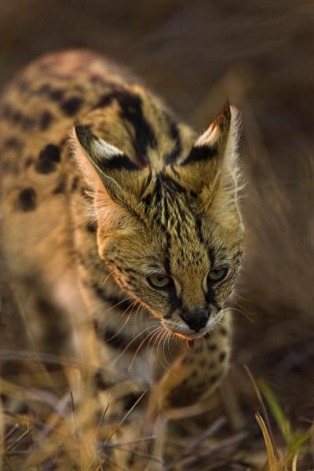Diet and Behavior
Diet

Serval hunting
Servals are carnivores, and eat a variety of prey, including birds, hares, hyraxes, snakes, lizards, frogs, and insects. 90% of the prey that a serval catches weighs less than 7 ounces, which is less than 2% the average body weight of a female. However, if given the opportunity, they will go after larger animals, such as small antelope. They are also notorious poultry stealers, though farmers like having them around because they also get rid of small, pesky animals, like mice. Servals devour their meals quickly, sometimes too quickly, causing them to regurgitate their food because of clogging of the throat.
Servals have a very unique hunting style. They will wait, sometimes for 15 minutes at a time, and listen for their prey. Their large ears capture sounds like a radar dish, enabling them to hear even the slightest movement. After the serval has heard its prey, it will pounce on it, often before even seeing the animal. It will force its weight down on the victim, usually shocking or killing it. However, if the animal is still alive, the serval will kill it with a quick bite to the neck. If the animal scurries down a burrow, a serval can easily take it out with its long legs. They also catch birds, even right out of the air. They can leap up to 10 feet catch their in-flight prey!
Servals have a very unique hunting style. They will wait, sometimes for 15 minutes at a time, and listen for their prey. Their large ears capture sounds like a radar dish, enabling them to hear even the slightest movement. After the serval has heard its prey, it will pounce on it, often before even seeing the animal. It will force its weight down on the victim, usually shocking or killing it. However, if the animal is still alive, the serval will kill it with a quick bite to the neck. If the animal scurries down a burrow, a serval can easily take it out with its long legs. They also catch birds, even right out of the air. They can leap up to 10 feet catch their in-flight prey!
Behavior

Serval
Servals are crepuscular, meaning they hunt in the early morning or dusk. They usually sleep in the middle of the day, and for a very short time at night. In the daytime, a serval can be very hard to see, because of its unique camouflage. When they hunt, they listen, and then pounce. They will often play with their food before eating it.
Servals can make a variety of different sounds, including growling, purring, snarling, spitting, and a high pitched cry that they use to call other servals.
Servals are mostly solitary, living in their territories until it is time to mate. The serval kittens are born in litters of two to four. The mother is the only parent that raises them, so she has to feed and take care of the newborn kittens. She is very protective of them, hiding them well, and changing the hiding place frequently. As soon as the kittens are old enough to hunt by themselves, the female drives the male kittens out. The young females stay a little bit longer, but have to leave to establish their own territories when they are sexually mature, which is usually around the age of 2 years old. Females who have overlapping territories are usually related to each other.
Servals can make a variety of different sounds, including growling, purring, snarling, spitting, and a high pitched cry that they use to call other servals.
Servals are mostly solitary, living in their territories until it is time to mate. The serval kittens are born in litters of two to four. The mother is the only parent that raises them, so she has to feed and take care of the newborn kittens. She is very protective of them, hiding them well, and changing the hiding place frequently. As soon as the kittens are old enough to hunt by themselves, the female drives the male kittens out. The young females stay a little bit longer, but have to leave to establish their own territories when they are sexually mature, which is usually around the age of 2 years old. Females who have overlapping territories are usually related to each other.
For More Information:
On Servals (listen to a serval purr): http://www.sandiegozoo.org/animalbytes/t-serval.html
On Servals' Behavior: http://www.awf.org/content/wildlife/detail/serval
On Servals' Behavior: http://www.awf.org/content/wildlife/detail/serval
____________________________________________________
This website was created by: Georgina Del Vecho Period 6
This website was created by: Georgina Del Vecho Period 6
